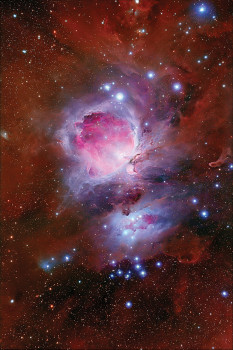John Lauder
Betelgeuse is the ninth-brightest star in the night sky and second-brightest in the constellation of Orion. Betelgeuse is easy to spot with the naked eye owing to its distinctive orange-red color. In the Northern Hemisphere, beginning in January of each year, it can be seen rising in the east just after sunset. Distinctly reddish, it is a semi regular variable star whose apparent magnitude varies between 0.2 and 1.2, the widest range of any first-magnitude star. Red Betelgeuse is found to the left and above Orion’s belt of three stars that make up the Winter Triangle. The star is classified as a red supergiant and is one of the largest and most luminous observable stars. If Betelgeuse were at the center of the Solar System, its surface would extend past the asteroid belt, possibly to the orbit of Jupiter and beyond, wholly engulfing Mercury, Venus, Earth and Mars. Estimates of its mass range from five to 30 times compared to the Sun. Its distance from Earth was estimated in 2008 at 640 light-years. Less than 10 million years old, Betelgeuse has evolved rapidly because of its high mass. Having been ejected from its birthplace in Orion, which includes the stars in Orion’s Belt, this crimson runaway has been observed moving through the interstellar medium at a supersonic speed of 30 km/s, creating a bow shock over four light-years wide. Currently in a late stage of stellar evolution, the supergiant is expected to proceed through its life cycle before exploding as a type II supernova within the next million years. An observation by the Herschel Space Observatory in January 2013 revealed that the star’s winds are crashing against the surrounding interstellar medium.
Different hypotheses have been put forward to explain Betelgeuse’s pulsations and their rhythm. Established theories of stellar structure suggest that the outer layers of this supergiant gradually expand and contract, causing the surface area (photosphere) to alternately increase and decrease and the temperature to rise and fall-—thereby causing the changes in the star’s brightness between its dimmest magnitude of 1.2, seen as early as 1927 and its brightest of 0.2, seen in 1933 and 1942. A red supergiant like Betelgeuse will pulsate this way because its stellar atmosphere is unstable. As the star contracts it absorbs more and more of the energy that passes through it, causing the atmosphere to heat up and expand. Conversely, as the star expands, its atmosphere becomes less dense allowing the energy to escape and the atmosphere to cool, thus initiating a new contraction phase. Betelgeuse is the brightest near-infrared source in the sky. As a result, only about 13% of the star’s radiant energy is emitted in the form of visible light. If human eyes were sensitive to radiation at all wavelengths, Betelgeuse would appear as the brightest star in the sky.
Our March meeting is on March 8 provided by SaddleBrooke native Mark Schwartz. His topic will be Aerial Celestial Navigation. Our meeting is at the MountainView Clubhouse Ballroom West at 7:00 p.m. Star parties (an opportunity to look through Skygazer member telescopes) are scheduled at the softball fields on Tuesday, February 17 and Wednesday, March 18 at dusk, weather permitting.

